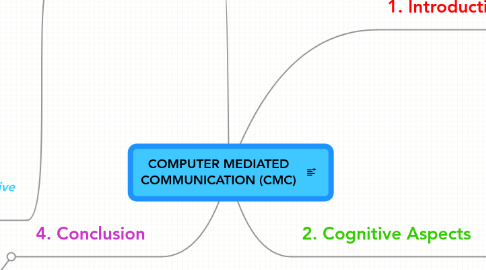
1. 3. Social Aspects
1.1. A) Dialogue & Motivation
1.1.1. Zone of Proximal Development (ZPD)
1.1.2. Absorption
1.1.3. Engrossment
1.1.4. Moderator
1.2. B) Group Dynamic & Leadership
1.2.1. Student-centred
1.2.2. Teacher-facilitator
1.2.3. Contextualizing Functions
1.2.3.1. 1. Opening Discussions
1.2.3.2. 2. Setting the Norms
1.2.3.3. 3. Setting the Agenda
1.2.3.4. 4. Referring
1.2.4. Monitoring Functions
1.2.4.1. 5. Recognition
1.2.4.2. 6. Prompting
1.2.4.3. 7. Assessing
1.2.5. Meta Functions
1.2.5.1. 8. Meta-commenting
1.2.5.2. 9. Weaving
1.2.5.3. 10. Delegating
1.3. C) Moderating Functions in the Dynamics of Engaged Collaborative Discourse
1.3.1. Addresses the central problem of computer conferencing - online leadership
1.3.2. Mediates communication & intellectual engagement
1.3.3. Ensures that the building of a common ground aids problem solving & convergence
2. 4. Conclusion
2.1. A) Model of Collaborative Discourse in Computer Conferencing
2.1.1. Intellectual Engagement
2.1.2. Communication Processes
2.1.3. Dialogue & Intrinsic Motives
2.1.4. Moderating Functions
3. 2. Cognitive Aspects
3.1. A) Intellectual Engagement (Critical Thinking)
3.1.1. Stage 1 - Problem Identification
3.1.2. Stage 2 - Definition
3.1.3. Stage 3 - Exploration
3.1.4. Stage 4 - Applicability
3.1.5. Stage 5 - Integration
3.2. B) Communication & Common Ground
3.2.1. Content Specification
3.2.2. Content Grounding
3.2.3. Presentation
3.2.4. Acceptance
3.3. C) Relationship between Intellectual & Communicative Processes
3.3.1. Phase 1 - Topic Initiating
3.3.1.1. Foreground
3.3.1.2. Background
3.3.2. Phase 2 - Multi-logue
3.3.2.1. Foreground
3.3.2.2. Background
3.3.3. Phase 3 - Common-logue
3.3.3.1. Foreground
3.3.3.2. Background
4. 1. Introduction
4.1. A) Context & Purpose
4.1.1. To explain the implications of the differences b/w written and oral forms of engaged collaborative discourse for pedagogy in cyberspace
4.1.2. To explain online discussion in all its complexity
4.1.3. To contribute to a better understanding of the dynamics of engaged collaborative discourse in computer conferencing
4.2. B) Complexity of Online Discussions
4.2.1. Intellectual Engagement
4.2.2. Communication & Common Ground
4.2.3. Dialogue & Motivation
4.2.4. Group Dynamics & Leadership
